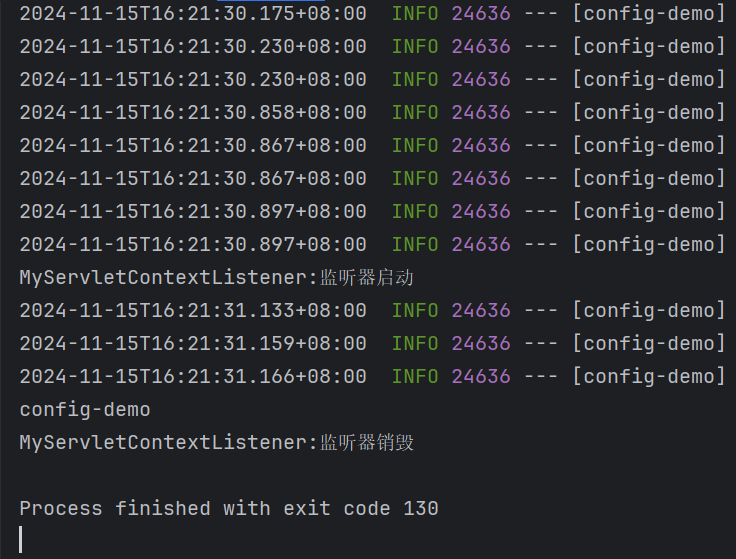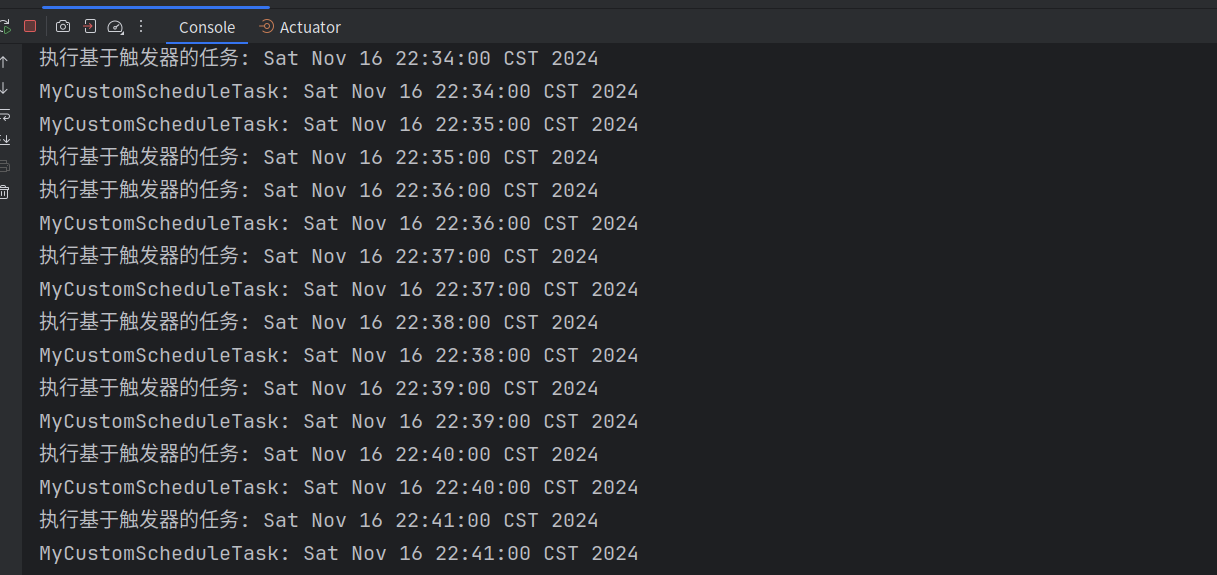在Spring Boot中,配置类是一种特殊的类,用于定义和配置Spring应用程序的各种组件、服务和属性。这些配置类通常使用Java注解来声明,并且可以通过Spring的依赖注入机制来管理和使用。
Spring 容器初始化时会加载被@Component、@Service、@Repository、@Controller等注解标识的类,除了注解标识的类,Spring容器还会加载配置类中定义的Bean。配置类通常使用@Configuration注解标识,它们中定义的方法会被Spring容器识别为Bean的创建方法。
本篇主要讲 Springboot 配置类一些常见的用法,按照 SpringBoot 加载顺序配置监听器,过滤器,拦截器,定时器以及读取自定义配置文件。
定义配置类
package com.shore.confittestdemo.config;import org.springframework.context.annotation.Configuration;@Configuration
public class MyConfig {}
监听器
`ServletContextListener接口
主要用于监听ServletContext对象的创建和销毁事件。它关注的是Web应用的启动和关闭,以及ServletContext对象的状态变化。
创建一个监听器类,实现ServletContextListener接口
package com.shore.configdemo.config.listener;import jakarta.servlet.ServletContextEvent;
import jakarta.servlet.ServletContextListener;
import jakarta.servlet.annotation.WebListener;@WebListener
public class MyServletContextListener implements ServletContextListener {@Overridepublic void contextInitialized(ServletContextEvent sce) {sce.getServletContext().setAttribute("myApp", "config-demo");System.out.println("MyServletContextListener:监听器启动");}@Overridepublic void contextDestroyed(ServletContextEvent sce) {System.out.println(sce.getServletContext().getAttribute("myApp"));System.out.println("MyServletContextListener:监听器销毁");}
}注解 @WebListener 标记为一个监听器类(没啥用)
@Beanpublic ServletContextListener servletContextListener() {return new MyServletContextListener();}
系统启动时上下文添加 app 信息,系统退出时,获取上下文的 app 信息

ApplicationListener 接口
主要用于监听Spring应用生命周期中的事件,如应用启动、上下文刷新、自定义事件等。它关注的是Spring容器内部的事件。
监听上下文刷新事件
创建一个监听器类,实现 ApplicationListener 接口,指定要监听的事件类型,ContextRefreshedEvent 或者 ContextClosedEvent 或者其他自定义类型的事件,重写 onApplicationEvent 方法,编写监听到事件后需要执行的逻辑。
package com.shore.configdemo.config.listener;import jakarta.servlet.annotation.WebListener;
import org.springframework.context.ApplicationEvent;
import org.springframework.context.ApplicationListener;
import org.springframework.context.event.ContextRefreshedEvent;
import org.springframework.stereotype.Component;@WebListener
//@Component
public class MyApplicationListener implements ApplicationListener<ContextRefreshedEvent> {@Overridepublic void onApplicationEvent(ContextRefreshedEvent event) {System.out.println("MyApplicationListener: 监听到上下文刷新" + event);}@Overridepublic boolean supportsAsyncExecution() {return ApplicationListener.super.supportsAsyncExecution();}
}配置类中注册 监听器
@Beanpublic MyApplicationListener listener() {return new MyApplicationListener();}

项目启动创建上下文时被 ServletContextListener 监听到,更新上下文信息,然后被 ApplicationListener 监听器捕获到。
监听上下文刷新和上下文关闭事件
有时候我们希望在一个监听器中监听多个事件,而不是每个事件增加一个监听器类,这时我们可以采用在自定义方法上增加注解 @EventListener,指定要监听的事件类型,一个类中可以有多个注解监听多个事件。
package com.shore.configdemo.config.listener;import jakarta.servlet.annotation.WebListener;
import org.springframework.context.event.ContextClosedEvent;
import org.springframework.context.event.ContextRefreshedEvent;
import org.springframework.context.event.EventListener;@WebListener
public class MyMultiEventListener {@EventListenerpublic void handleContextRefreshEvent(ContextRefreshedEvent event) {System.out.println("MyMultiEventListener.handleContextRefreshEvent:监听到上下文刷新");}@EventListenerpublic void handleContextClosedEvent(ContextClosedEvent event) {System.out.println("MyMultiEventListener.handleContextClosedEvent:监听到上下文关闭");}
}
监听多个自定义事件
实际业务中,我们可能需要监听一些其他的业务,比如类初始化等,可以通过自定义事件来完成。
创建一个类继承 ApplicationEvent 定义一个事件
package com.shore.configdemo.config.event;import org.springframework.context.ApplicationEvent;public class MyCustomEvent extends ApplicationEvent {private String message;public MyCustomEvent(Object source) {super(source);}public MyCustomEvent(Object source, String message) {super(source);this.message = message;}public String getMessage() {return message;}
}定义一个类,调用 ApplicationEventPublisher 接口发布事件
package com.shore.configdemo.config.publisher;import com.shore.configdemo.config.event.MyCustomEvent;
import jakarta.annotation.Resource;
import org.springframework.context.ApplicationEventPublisher;
import org.springframework.stereotype.Component;@Component
public class MyEventPublisher {@Resourceprivate ApplicationEventPublisher eventPublisher;public void publishEvent() {MyCustomEvent myCustomEvent = new MyCustomEvent(this, "Hello, this is custom event");eventPublisher.publishEvent(myCustomEvent);}
}在启动类或其他地方调用发布事件方法
package com.shore.configdemo;import com.shore.configdemo.config.publisher.MyEventPublisher;
import jakarta.annotation.Resource;
import org.springframework.boot.CommandLineRunner;
import org.springframework.boot.SpringApplication;
import org.springframework.boot.autoconfigure.SpringBootApplication;@SpringBootApplication
public class ConfigDemoApplication implements CommandLineRunner {@Resourceprivate MyEventPublisher myEventPublisher;public static void main(String[] args) {SpringApplication.run(ConfigDemoApplication.class, args);}@Overridepublic void run(String... args) throws Exception {myEventPublisher.publishEvent();}
}监听自定义事件
@EventListenerpublic void handleMyCustomEvent(MyCustomEvent event) {System.out.println("MyMultiEventListener.handleContextClosedEvent:监听到自定义事件:" + event.getMessage());}

过滤器
Spring Boot 中的过滤器(Filter)主要用于对请求和响应进行预处理或后处理,常用于处理诸如日志记录、身份验证、头信息处理、请求修改等任务。
新建一个过滤器类,继承 javax.servlet.Filter 接口,也可以继承 OncePerRequestFilter 类,它确保在一次请求中只通过一次filter,无需显式检查是否已过滤。
package com.shore.configdemo.config.filter;import jakarta.servlet.FilterChain;
import jakarta.servlet.ServletException;
import jakarta.servlet.http.HttpServletRequest;
import jakarta.servlet.http.HttpServletResponse;
import org.springframework.web.filter.OncePerRequestFilter;import java.io.IOException;public class MyCustomFilter extends OncePerRequestFilter {@Overrideprotected void doFilterInternal(HttpServletRequest request, HttpServletResponse response, FilterChain filterChain) throws ServletException, IOException {// 过滤器前执行的操作System.out.println("MyCustomFilter: Before doFilter");System.out.println("Request URI: " + request.getRequestURI());System.out.println("Request Method: " + request.getMethod());// 继续过滤器链filterChain.doFilter(request, response);// 过滤器后执行的逻辑System.out.println("MyCustomFilter: After doFilter");System.out.println("Response Status: " + response.getStatus());}
}在配置类中注册过滤器
@Beanpublic FilterRegistrationBean<MyCustomFilter> myCustomFilter() {FilterRegistrationBean<MyCustomFilter> filterRegistrationBean = new FilterRegistrationBean<>();filterRegistrationBean.setFilter(new MyCustomFilter());// 设置特定过滤路径filterRegistrationBean.addUrlPatterns("/*");// 设置过滤器顺序filterRegistrationBean.setOrder(1);return filterRegistrationBean;}
通过postman 或者 http 请求在配置类中配置范围的控制器

拦截器
Spring Boot 中的拦截器(Interceptor)主要用于拦截和处理 Spring MVC 框架中的 HTTP 请求和响应。与过滤器(Filter)相比,拦截器更侧重于对 Spring MVC 框架内的请求进行处理,例如,处理控制器方法的前后逻辑。
创建一个拦截器类实现 HandlerInterceptor 接口,重写接口的三个方法 preHandle、postHandle 和 afterCompletion,分别用于在请求处理前、请求处理后(但在视图渲染之前)以及整个请求完成后进行拦截。
package com.shore.configdemo.config.interceptor;import jakarta.servlet.http.HttpServletRequest;
import jakarta.servlet.http.HttpServletResponse;
import org.springframework.web.servlet.HandlerInterceptor;
import org.springframework.web.servlet.ModelAndView;public class MyCustomInterceptor implements HandlerInterceptor {@Overridepublic boolean preHandle(HttpServletRequest request, HttpServletResponse response, Object handler) throws Exception {// 在控制器方法执行之前调用System.out.println("MyCustomInterceptor: Pre Handle method is Calling");// 如果返回 false,将中断请求,不会调用后续的拦截器和控制器方法return true;}@Overridepublic void postHandle(HttpServletRequest request, HttpServletResponse response, Object handler, ModelAndView modelAndView) throws Exception {// 在控制器方法执行之后,视图渲染之前调用System.out.println("yCustomInterceptor: Post Handle method is Calling");}@Overridepublic void afterCompletion(HttpServletRequest request, HttpServletResponse response, Object handler, Exception ex) throws Exception {// 在整个请求完成之后调用(包括视图渲染和异常处理)System.out.println("Request and Response is completed");}
}配置类中注册拦截器,与监听器和过滤器不同,注册拦截器的配置类需要实现 WebMvConfigurer 接口,并重写他的 addInterceptors 方法。
package com.shore.configdemo.config;import com.shore.configdemo.config.filter.MyCustomFilter;
import com.shore.configdemo.config.interceptor.MyCustomInterceptor;
import com.shore.configdemo.config.listener.MyApplicationListener;
import com.shore.configdemo.config.listener.MyMultiEventListener;
import com.shore.configdemo.config.listener.MyServletContextListener;
import jakarta.annotation.Resource;
import jakarta.servlet.ServletContextListener;
import org.springframework.boot.web.servlet.FilterRegistrationBean;
import org.springframework.context.annotation.Bean;
import org.springframework.context.annotation.Configuration;
import org.springframework.web.servlet.config.annotation.InterceptorRegistry;
import org.springframework.web.servlet.config.annotation.WebMvcConfigurer;@Configuration
public class MyConfig implements WebMvcConfigurer {@Resourceprivate MyCustomInterceptor myCustomInterceptor;@Beanpublic FilterRegistrationBean<MyCustomFilter> myCustomFilter() {FilterRegistrationBean<MyCustomFilter> filterRegistrationBean = new FilterRegistrationBean<>();filterRegistrationBean.setFilter(new MyCustomFilter());// 设置特定过滤路径filterRegistrationBean.addUrlPatterns("/*");// 设置过滤器顺序filterRegistrationBean.setOrder(1);return filterRegistrationBean;}@Overridepublic void addInterceptors(InterceptorRegistry registry) {registry.addInterceptor(myCustomInterceptor).addPathPatterns("/**") // 拦截特定的请求.excludePathPatterns("/login"); // 排除特定的请求}
}一旦拦截器被注册到 Spring Boot 应用中,它就会自动对匹配的请求起作用。根据你的配置(如路径模式),每次符合条件的请求都会先经过拦截器,然后再继续处理。
我们在控制器新增两个方法,一个 post 方法用来访问,一个 get 方法用来拦截器重定向,拦截器建议重定向 get 方法
package com.shore.configdemo.web;import org.springframework.web.bind.annotation.GetMapping;
import org.springframework.web.bind.annotation.PostMapping;
import org.springframework.web.bind.annotation.RequestParam;
import org.springframework.web.bind.annotation.RestController;@RestController
public class MyCustomController {@PostMapping("/sayHello")public String sayHello() {System.out.println("sayHello");return "Hello World";}@GetMapping("/login")public String login() {System.out.println("login");return "login success";}
} 我们来分析以下上图的链路,首先我们调用 sayHllo 方法走到过滤器的链路,打印过滤器链之前的逻辑,然后继续后面的过滤器链,接着请求被拦截器拦截到,执行拦截器 preHandler 方法,该方法 重定向到 login 并结束当前链路,不再访问 sayHello,接着 login 又被过滤器捕获到,执行过滤前逻辑,然后被拦截器放行,访问到 login 接口,正常返回又被过滤器捕获到,执行过滤器后置逻辑,至此链路结束。
我们来分析以下上图的链路,首先我们调用 sayHllo 方法走到过滤器的链路,打印过滤器链之前的逻辑,然后继续后面的过滤器链,接着请求被拦截器拦截到,执行拦截器 preHandler 方法,该方法 重定向到 login 并结束当前链路,不再访问 sayHello,接着 login 又被过滤器捕获到,执行过滤前逻辑,然后被拦截器放行,访问到 login 接口,正常返回又被过滤器捕获到,执行过滤器后置逻辑,至此链路结束。
我们将拦截器中判断 session 返回 false 的逻辑删掉,重新访问 sayHello,执行一次完整的拦截器逻辑.
 这里我们可以看到先走到过滤器前置逻辑,接着拦截器 preHandle 方法,然后走到sayHello 接口,然后走到拦截器 postMethod 方法,然后是拦截器 afterCompletion 方法,最后走到过滤器后值逻辑。
这里我们可以看到先走到过滤器前置逻辑,接着拦截器 preHandle 方法,然后走到sayHello 接口,然后走到拦截器 postMethod 方法,然后是拦截器 afterCompletion 方法,最后走到过滤器后值逻辑。
定时器
在Spring Boot中,实现定时器功能通常有几种方法,包括使用@Scheduled注解、TaskScheduler接口以及通过@EnableScheduling和配置类来设定定时任务。
@Scheduled注解
@Scheduled注解提供了最简便的方式来声明定时任务。你只需在相应的方法上添加此注解,并指定相应的cron表达式或其他定时规则。
首先,确保你的Spring Boot应用已经启用了定时任务支持,这通常通过在主应用类或配置类上添加@EnableScheduling注解来实现。
package com.shore.configdemo;import com.shore.configdemo.config.publisher.MyEventPublisher;
import jakarta.annotation.Resource;
import org.springframework.boot.CommandLineRunner;
import org.springframework.boot.SpringApplication;
import org.springframework.boot.autoconfigure.SpringBootApplication;
import org.springframework.scheduling.annotation.EnableScheduling;@SpringBootApplication
@EnableScheduling
public class ConfigDemoApplication implements CommandLineRunner {@Resourceprivate MyEventPublisher myEventPublisher;public static void main(String[] args) {SpringApplication.run(ConfigDemoApplication.class, args);}@Overridepublic void run(String... args) throws Exception {myEventPublisher.publishEvent();}
}创建一个定时任务类,方法使用 @Scheduled 注解标记
package com.shore.configdemo.config.schedule;import org.springframework.scheduling.annotation.Scheduled;import java.util.Date;public class MyCustomScheduleTask {@Scheduled(cron = "0 * * * * *")public void myScheduleTask() {System.out.println("MyCustomScheduleTask: " + new Date());}
}配置类注册定时任务类
@Beanpublic MyCustomScheduleTask myCustomScheduleTask() {return new MyCustomScheduleTask();}

TaskScheduler接口
如果你需要更细粒度的控制,比如任务池、线程管理等,你可以直接使用TaskScheduler接口。首先,定义一个TaskScheduler的bean
@Beanpublic TaskScheduler taskScheduler() {ThreadPoolTaskScheduler taskScheduler = new ThreadPoolTaskScheduler();taskScheduler.setPoolSize(10);return taskScheduler;}
然后,你可以注入TaskScheduler并使用它来调度任务
package com.shore.configdemo.service.impl;import com.shore.configdemo.service.MyService;
import jakarta.annotation.Resource;
import org.springframework.scheduling.TaskScheduler;
import org.springframework.stereotype.Service;import java.util.Date;@Service
public class MyServiceImpl implements MyService {@Resourceprivate TaskScheduler taskScheduler;@Overridepublic void sayHello(String name) {}public void scheduleTask() {taskScheduler.scheduleWithFixedDelay(() -> {System.out.println("执行定时任务: " + new Date());}, 5000); // 任务间隔5秒}
}
@EnableScheduling和配置类
前面已经提到了@EnableScheduling注解,它用于启用Spring的计划任务调度功能。通常,你只需在主应用类或任何配置类上添加此注解,然后就可以在你的应用中使用@Scheduled注解来声明定时任务了。
除了简单的启用定时任务外,你还可以通过实现SchedulingConfigurer接口来自定义定时任务的配置,比如设置任务执行器(TaskExecutor)或任务调度器(TaskScheduler)的属性。
package com.shore.configdemo.config;import org.springframework.context.annotation.Configuration;
import org.springframework.scheduling.annotation.EnableScheduling;
import org.springframework.scheduling.annotation.SchedulingConfigurer;
import org.springframework.scheduling.config.ScheduledTaskRegistrar;
import org.springframework.scheduling.support.CronTrigger;import java.util.Date;@Configuration
@EnableScheduling
public class MyCustomSchedulingTask implements SchedulingConfigurer {@Overridepublic void configureTasks(ScheduledTaskRegistrar taskRegistrar) {taskRegistrar.addTriggerTask(() -> System.out.println("执行基于触发器的任务: " + new Date()),triggerContext -> {// 自定义触发器逻辑,比如根据时间或条件来决定是否执行任务return new CronTrigger("0 * * * * *").nextExecutionTime(triggerContext).toInstant();});}
}
配置文件属性
自定义配置文件 custom-config.yaml
my-app:auth-filter:secretKey: mySecretKeyexpirationTime: 864000000 # 10 天excludes:- /shore/demo/user/login- /shore/demo/user/register- /shore/demo/user/querysnowflake:workerId: 1datacenterId: 1
application.yaml 文件配置自定义配置文件的路径
spring:config:import: classpath:custom-config.yaml
创建配置文件类,指定要读取的标签,定义要读取的属性
package com.shore.my_spring_demo.web.config;import lombok.Data;
import org.springframework.boot.context.properties.ConfigurationProperties;
import org.springframework.stereotype.Component;import java.util.List;@ConfigurationProperties(prefix = "my-app.auth-filter")
@Data
public class CustomAuthFilterConfig {private String secretKey;private long expirationTime;private List<String> excludes;
}配置类中注册配置文件类
@Beanpublic CustomAuthFilterConfig customAuthFilterConfig() throws NoSuchAlgorithmException {return new CustomAuthFilterConfig();}
最后就可以在服务中生命使用了
package com.shore.my_spring_demo.service.jwt;import com.shore.my_spring_demo.common.enums.ErrorEnums;
import com.shore.my_spring_demo.exception.UsersException;
import com.shore.my_spring_demo.web.config.CustomAuthFilterConfig;
import io.jsonwebtoken.Claims;
import io.jsonwebtoken.Jwts;
import io.jsonwebtoken.SignatureAlgorithm;
import lombok.extern.slf4j.Slf4j;
import org.springframework.stereotype.Service;import javax.annotation.Resource;
import java.security.KeyPair;
import java.util.Date;@Slf4j
@Service
public class JwtServiceImpl implements JwtService {@Resourceprivate CustomAuthFilterConfig customConfig;@Resourceprivate KeyPair keyPair;@Overridepublic String generateTokenAsymmetric(String username) {return Jwts.builder().claim("sub", username).claim("role", "admin").expiration(new Date(System.currentTimeMillis() + customConfig.getExpirationTime())).signWith(SignatureAlgorithm.RS256, keyPair.getPrivate()).compact();}
}总结
上述所有在配置类中注册的类,大多都可以直接通过注解 @Compent 标记这种简单的方法进行注册,但是如果想要更加精细化的操作,还是需要在配置类中通过 bean 管理注册。
 | SpringBoot配置多个数据源)


--高级函数特性详解)

固态硬盘并未锁定 互换硬盘后仍可使用)


)










